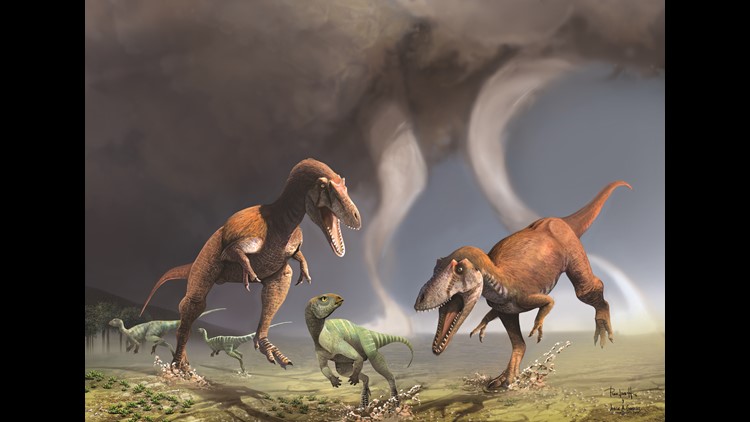![636040017349876484-escena-final-prensa.jpg [image : 87025224]](http://www.gannett-cdn.com/-mm-/4885f6977a40a31280292a17d863755ac93e069f/c=386-0-4796-3769/local/-/media/2016/07/13/USATODAY/USATODAY/636040017349876484-escena-final-prensa.jpg)
Maybe this dinosaur really, really didn’t want to be found.
Scientists digging for fossils in rural Argentina found themselves beset by misfortune, ranging from bureaucratic interference to a serious truck accident. Now the researchers have given an appropriate name to the strange new species they finally discovered: Gualicho, the local word for a curse.
If bad luck befalls anyone in the region where the fossil was uncovered, “people say that somebody made a gualicho on you,” says paleontologist Sebastián Apesteguía of the Azara Foundation in Buenos Aires, co-author of a study in this week’s PLOS ONE about the new animal. Of all the dinosaurs he’s worked on recently, “this was the most difficult by far.”
Gualicho was found on the second-to-last day of the scientists’ research at the site. Study co-author Peter Makovicky recalls he jokingly ordered one of his workers “to go find something.” Minutes later, “she did.”
![636040016995283938-rolled-truck.jpg [image : 87025228]](http://www.gannett-cdn.com/-mm-/cb2705078c8d8f0351377568375c8b64b5903885/c=141-0-2163-1728/local/-/media/2016/07/13/USATODAY/USATODAY/636040016995283938-rolled-truck.jpg)
What she found was a meat-eating dinosaur from the Late Cretaceous that stood upright on two slender legs, making it “reasonably speedy,” says Makovicky of The Field Museum in Chicago. It weighed as much as a big Clydesdale and would’ve towered over a six-foot-tall human.
But Gualicho could’ve used a little upper-body work. Its short arms — roughly as long as a child’s — were shriveled and apparently not very useful. Instead, the animal probably relied on powerful jaws to grab and grip its quarry, scientists say.
Gualicho is in good company. Both T. rex and its fellow tyrannosaurs had stumpy arms, as did a separate clan of upright carnivorous dinosaurs. But Gualicho is on a different branch on the dinosaur family tree from the others, meaning it must have evolved puny arms independently.
Gualicho makes it clear that these two-legged predatory dinosaurs “were doing a lot of interesting things with their hands,” says George Washington University paleontologist James Clark, who was not affiliated with the new study. “This shows there’s more going on than we thought.”
The discovery will help researchers understand why dinosaurs’ arms became tiny, says another outside scientist. “Having more examples allows us to better test different hypotheses about why arm reduction may have occurred,” says Matthew Carrano of the Smithsonian Institution’s National Museum of Natural History.
![636040017155029986-huesos-gualicho6-2.jpg [image : 87025226]](http://www.gannett-cdn.com/-mm-/a0ffb22e7a741296d608c3a11c201daf6b534d9e/c=3402-0-12045-7387/local/-/media/2016/07/13/USATODAY/USATODAY/636040017155029986-huesos-gualicho6-2.jpg)
Gualicho is not only a separate example but also a weird one. Some of its body parts, such as its hind limbs, look like they belong to more primitive animals, while its two-fingered “hands” look like those of the formidable T. rex. Gualicho is a pastiche of a dinosaur, making it difficult for researchers to understand exactly how it relates to others.
But that also makes it an interesting challenge, one worthy of the arduous process of finding it in the first place. It took eight years of “talking and talking and talking” with a suspicious landowner in northwestern Argentina before he finally agreed to let the scientists scour his sheep ranch, Apesteguía says. Partway through the excavations, the truck Makovicky was driving began to fishtail and then flipped. No one was badly hurt, but the truck was a total loss.
After the fossil was discovered, the researchers were denied access to it for several years through the machinations of local authorities, Apesteguía says. It took an election and a new political regime for the scientists to reunite with their fossil again.
“It’s been a long journey,” agrees Makovicky. “But it’s certainly an interesting animal and well worth it.”



